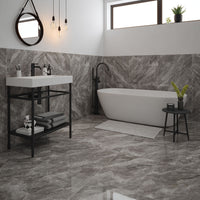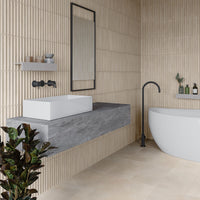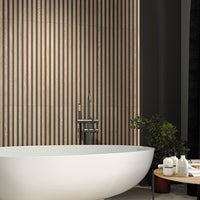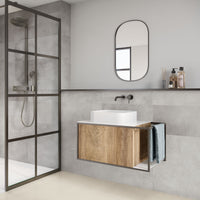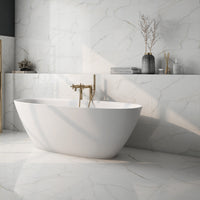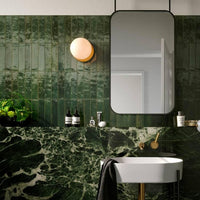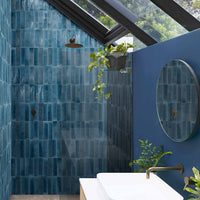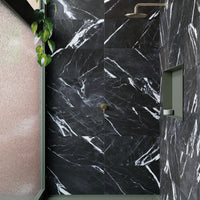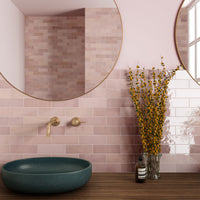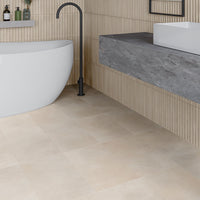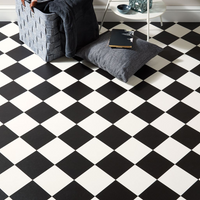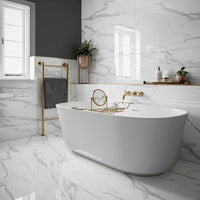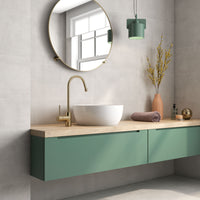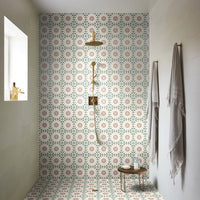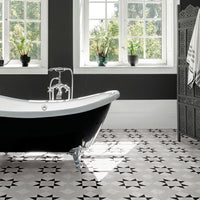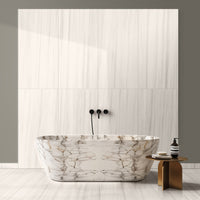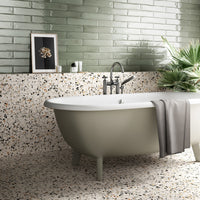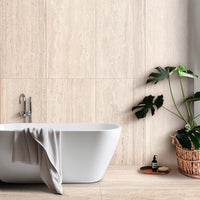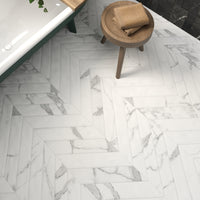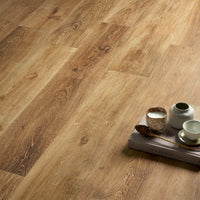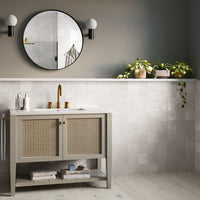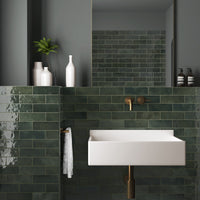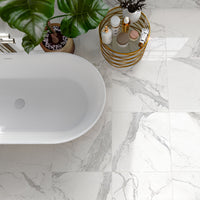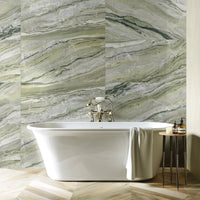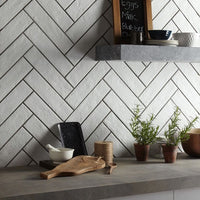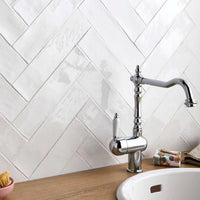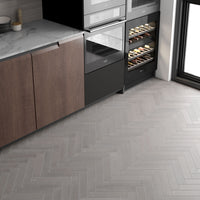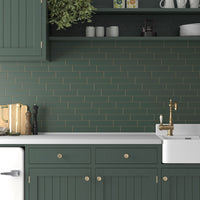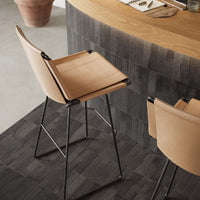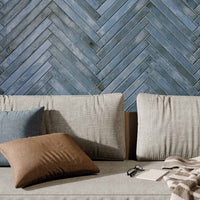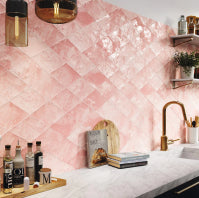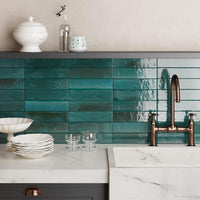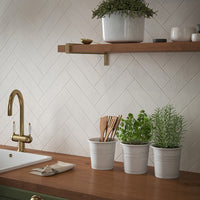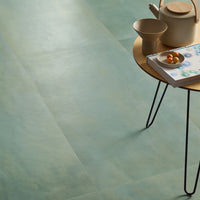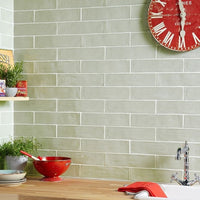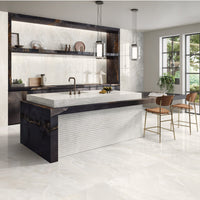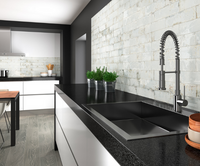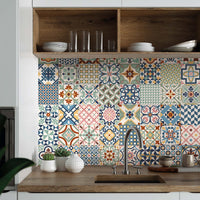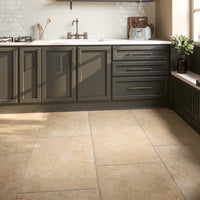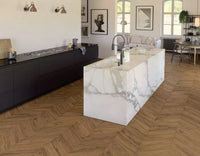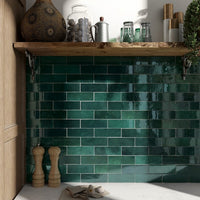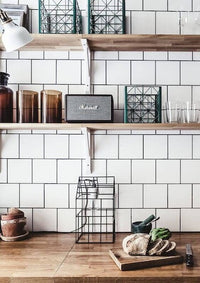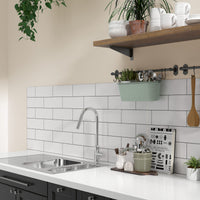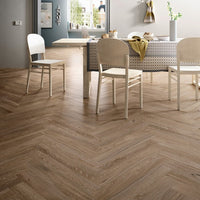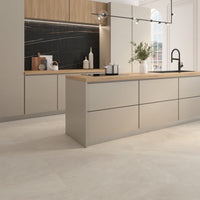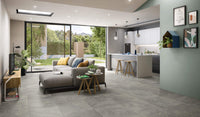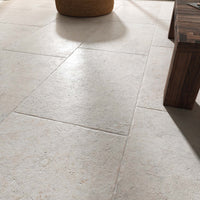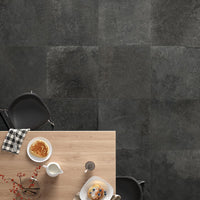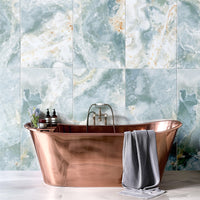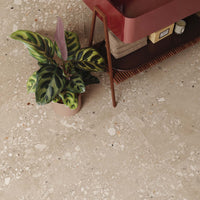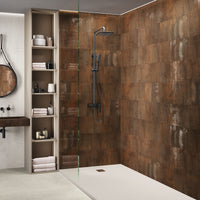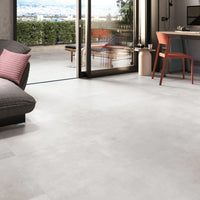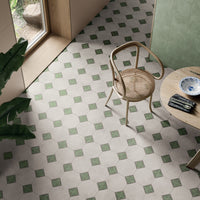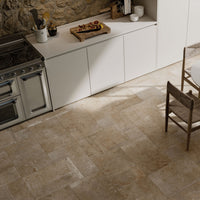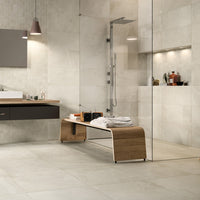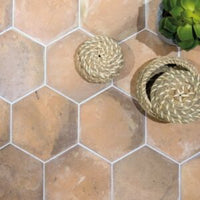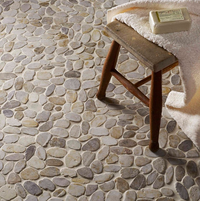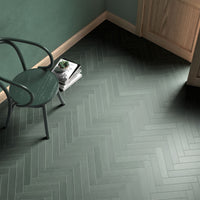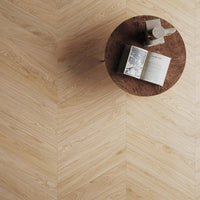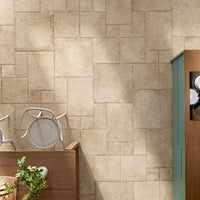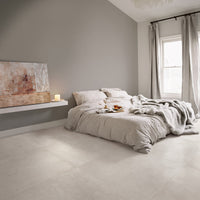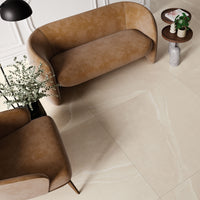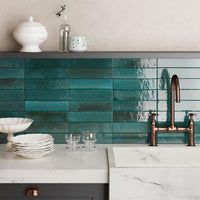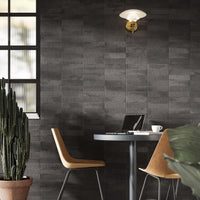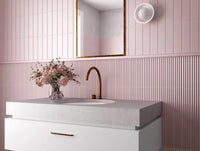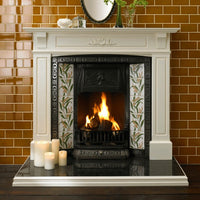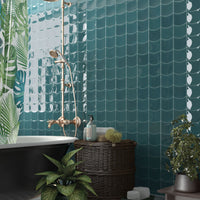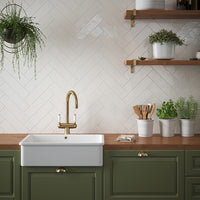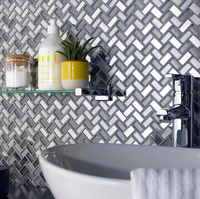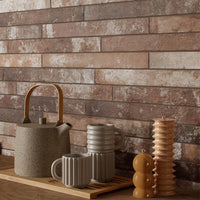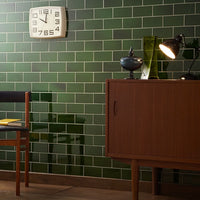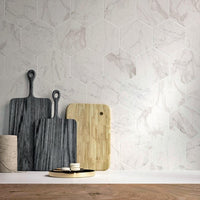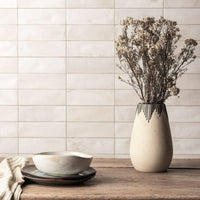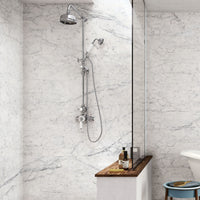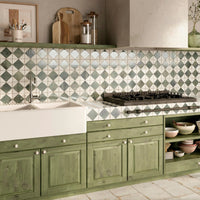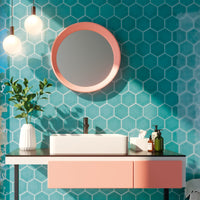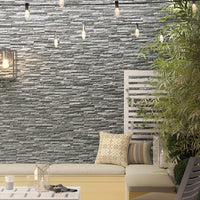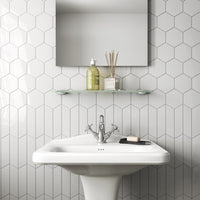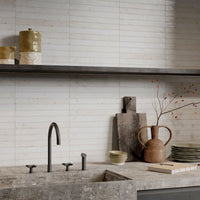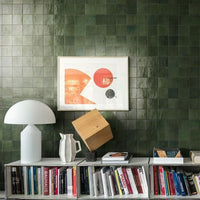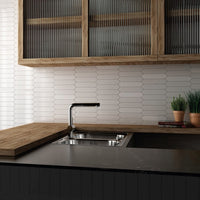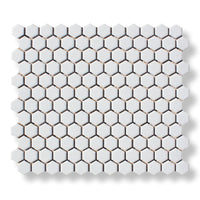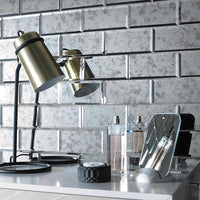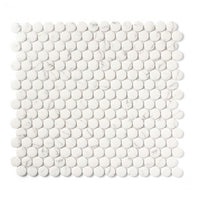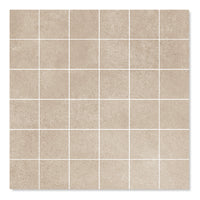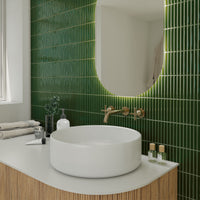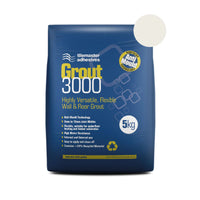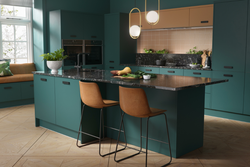For us, when it comes to making wonderful walls it's tiles all the way. Whether you have your eyes on a traditional metro tile or prefer something a bit more modern, our wall tiles will jazz up any interior. And they don’t just look great, they’re easy to live with too - an important consideration for busy family homes.
But with hundreds of designs available, making the right choice can be overwhelming. In this article, we’ll cover everything you need to know, giving you the confidence to tackle your next interior project head on.
Different types of wall tile
In the not-so-distant past, most wall tiles were made from ceramic. While this still rings true today, you’ll also find plenty of designs made from other materials.
- Ceramic wall tiles are ideal for almost any interior wall. They’re durable, easy to clean and offer the most cost-effective option.
- Porcelain wall tiles are a harder form of ceramic. They can be fixed to outside walls and are perfect for wet shower areas.
- Although they’re usually more expensive, glass wall tiles offer a wipe-clean, contemporary splashback for kitchen hobs.
- Stone wall tiles are gradually being phased out in favour of ceramic and porcelain, as they’re expensive and difficult to maintain
- Mosaic tiles always create a dramatic talking point. They often feature different materials, for extra style impact.
Benefits of tiling your walls
When it comes to our homes, we naturally want our rooms to shine. So it goes without saying that your walls are important - after all, they’re such a huge and visible aspect of any interior space.
And naturally, good design also has an impact on our well-being. Studies have shown that great design can increase mental-wellbeing and lower anxiety levels. By choosing to tile your walls, you’re choosing a material that’s not only functional, but looks beautiful as well.
Easy to Clean
Why worry about delicate wallpapers when tiles are so easy to live with? Most stains can be quickly wiped away with just a damp cloth, while everyday household cleaners can be used if required.
Lifetime Value
Once you’ve tiled a wall, that’s it. Tiles are so durable that they won’t need replacing over time. This compares extremely favourably to a cheaper painted wall, which is likely to scuff and mark and will need to be repainted every couple of years.
Realistic Designs
The latest tile designs are almost identical to luxurious materials such as marble, without the expensive price tag. They’re also much kinder to the environment and don’t require specialist know-how to install.
Disadvantages of wall tiles
Although tiles offer numerous advantages compared to traditional wall-coverings, they can be a little more tricky to fit. For example, while you can paint over almost any wall, you can really only tile onto flat and stable substrates. This may require some messy and time-consuming preparation work.
Furthermore, as tiles are permanently fixed in place, they’re usually not a suitable option if you’re renting - unless you have the landlord’s permission.
Where can I use wall tiles?
One of the great advantages of ceramic and porcelain tiles is their versatility. Unlike paint or wallpaper, you can often lay the same tile on any wall at home, increasing the scope for creative design.
Bathrooms
Waterproof and hygienic, tiles are a natural choice for bathroom and shower walls. While white tiles are eternally popular, bathrooms are secondary spaces and a great opportunity to get adventurous. So why not express your personality through patterned or colourful wall tiling?
Kitchens, splashbacks
Tiles always do well in kitchens. Why? Because not only do they look good, they’re durable too. This means your wall or splashback will look its best, for years to come, with the minimum of fuss.
Utility rooms
You can use tiles in more functional spaces such as utility and boot rooms, or porches. While utilitarian styles such as Elements Square always work well here, why not add a twist using colour or pattern?
Fireplaces
As tiles are non-combustible, they’re a safe choice for walls around your fireplace or hearth. Crackle Glaze tiles work well in period properties, while patterned wall tiles can warm things up a little.
Feature walls
Tiling just one part of a wall is a tried and tested way to create a focal point. Our feature wall tiles are ideal for turning unloved chimney breasts or splashbacks into something special - colour, texture and pattern offer much more interest than plain painted walls.
Outside
You’ll need to use porcelain tiles outside, as they’re frost-proof and won’t crack or fade. Use our split-face designs to give your outside walls that rustic, multi-layered look.
Which wall tiles are best for me?
In the not-so-distant past, white metro tiles were ubiquitous and adorned almost any wall you could think of, from vintage bathrooms to hipster cafes.
But these days, with so many beautiful designs available, choosing your perfect wall tile is a little more difficult. There’s no one-size-fits-all here, so it’s best to consider a number of factors.
Style
What’s the look you’re going for in your new room? Is it classic, contemporary or somewhere in the middle? Or perhaps something a little more punchy and colourful. Whatever your interior style, it’s clear that some tiles will suit your space better than others.
For example, while the geometric lines of Arrows Matt White will add punch to a modern bathroom, they’re unlikely to work so well in a more traditional space.
Colour
It’s a well-known fact that we all react to colour. Different tones evoke different sensations; while certain tones are quiet and relaxing, others are more vibrant and energetic. So along with the style of a tile, the colour will have a huge impact on your interior.
- Lighter tones help increase the feeling of space, so they’re a natural choice for smaller en-suites and cloakrooms.
- Darker tones absorb light and make a room feel smaller. They’re ideal for cosier environments.
- Fresh and tranquil light blue tiles always work well in bathrooms, offering more personality than white tiles.
- Although it may seem counter-intuitive, if your room lacks natural light, we recommend choosing a darker green like Dwell Emerald. The deep, bold colouring offers more of a feature than paler tiles.
- There’s a reason why white wall tiles are so popular - fresh and clean, they look great almost anywhere.
Finish
As you’re no doubt aware, tiles are available in a number of different finishes and textures. These will play a huge part in how your room both looks, and feels.
- With their low sheen, matt wall tiles tend to offer a more contemporary look. They conceal dirt, blemishes and fingerprints quite well.
- Glossy wall tiles are shiny and reflective, so will help to make a room feel more spacious. They’re usually easy to clean, although the glaze may be easier to scratch.
- Some larger tiles are highly polished, giving a mirror-like reflective surface that’s ideal for luxurious bathrooms.
- Textured wall tiles are ideal for creating feature walls, as they’re naturally full of character and depth.
- Fluted details are making a comeback and their subtle groove will add pleasing texture to chic, minimal spaces.
Size
When it comes to wall tiles, two sizes are traditionally very popular - 7.5 x 15 and 10 x 20 cm. However, in recent years a longer 7.5 x 30 cm subway tile is fast-becoming the number choice for walls across the country. This size is incredibly versatile and suits both small and larger wall areas. It also looks fantastic when laid in a herringbone pattern - which is hugely on trend right now!
However, there’s a dizzying array of other sizes available, from dinky mosaics through to large scale porcelain slabs. The latter can measure up to 60 x 120 cm and while they’re designed for feature bathroom walls, they can also help increase the sense of space in smaller rooms, as there’s fewer grout joints to distract the eye.
Popular wall tile trends
Now that we've covered the background of wall tiles, it's time to delve into the fun part - the trends, colours and laying patterns that will make your new space stand out! Let's begin by looking at our favourite wall trends.
Metro Tiles
Needing little introduction, metro tiles are pretty ubiquitous. In fact, we often refer to white metro tiles as the blue jeans of the tile world. They're a cost effective way to make an impact - it's fair to say that their distinctive bevelled edge always looks good, wherever these tiles are laid.Hexagon Tiles
We love hexagon tiles - if there's an easier way to create an eye-catching feature, we've yet to find it. A huge trend in interiors right now, the distinctive honeycomb pattern adds modern geometric style to any room and can be grouted in different colours, to personalise your space.
White Marble
Inspired by beautiful Carrara and Calacatta natural stones, white marble tiles are ideal for creating elegant bathrooms, in particular. While the distinctive grey veins are a true design classic, the latest designs inject a little more colour with red and golden hues.
Stone Effect
Stone effect tiles have always been a popular choice in bathrooms, as they help to create a warm and inviting ambience in what should be a relaxing, soothing space. With plenty of natural style variation, they can make a smaller space feel more cosy, interesting and exciting.
Mosaics
There's a simple reason why mosaics are eternally popular - they offer a layer of love and a little more interest than plain painted walls. Although they're usually more expensive than other tiles, a little can go a long way. For example, a couple of sheets of Onice Pearl Mosaic will quickly enliven any kitchen splashback.
Zellige Tiles
Alongside green wall tiles, zellige-style tiles are the hottest trend when it comes to covering our walls. Just like the Moroccan originals, they will introduce a little imperfection and soul on your walls - the perfect foil for both glossy kitchens and designer bathroom spaces alike.
Matching Tiles
A huge trend, particularly in contemporary bathrooms, is to continue your floor tiles up onto your walls. By using the same material throughout, the room instantly feels more spacious with less visual distraction. Larger porcelain tiles such as Motion Sand are ideal for getting the look at home.
Popular wall tile colours
The colour you choose will play a huge part in setting your style agenda. Do you play it cool with a clinical white or opt for a soothing-yet-statement earthy hue? The choice is yours... but we're here to help.
White wall tiles
White tiles are a classic for a reason; they look good anywhere, period. However a variety of styles are on offer, from the simple effect of Haus Matt White, to the artisan splendour of Marais White or the textural delight that Brix White.
Green wall tiles
Nurtured by nature, green wall tiles are fast becoming the go-to tone for all areas of the home. Deeper shades such as Dwell Emerald or Marais Green are well suited to period and modern properties alike, being neither too warm nor too cold.
Pink wall tiles
Always fresh and fun, pink is currently the hottest hue in the interiors world. So it's little wonder that pink wall tiles are incredibly trendy. They will add cheer to any space, especially if you choose an abstract style such as Roxy Pink or Pop Pink.
Patterned wall tiles
Patterned tiles work wonders for giving modern interiors an extra layer of style, especially if you choose a colourful design such as Saigon Mix. Ideal for splashbacks, they will also make a striking statement over bathroom walls.
Grey wall tiles
Grey tiles are undoubtedly contemporary, yet they also have the ability to create calm interiors, as shown by Atlas Grey. To add extra intrigue to your walls, choose a tile with tonal variation, such as Onice Pearl Brick.
Popular wall tile patterns
Choosing your favourite wall tile is just part of the fun. Before it's installed, you'll also need to consider the laying pattern, as this will have a huge impact on the overall feel of your room.
Brickbond
Tried and tested over countless decades, you're guaranteed a great-looking wall space when you lay subway tiles in a traditional brick-bond fashion. It's a straightforward approach that lets your tiles do the talking - although you can choose a contrasting grout colour to add more drama.
Herringbone
The breakout pattern of the last few years, laying tiles in a herringbone format instantly makes them feel more ornamental and ornate. It's great way to elevate a simple splashback into something more extravagant, even if you're using relatively muted tiles.
Our tip - keep the rest of your room simple, to let your walls take centre stage.
Diamond
If you're using square wall tiles, you can lay them on an angle to add more movement and interest to your walls. A more traditional laying pattern, it offers an elevated, quilted effect and works particularly well in country-style kitchens or classic interiors.
Linear
If you're looking to create a modern interior that won't date, then the linear, or stacked, laying pattern could be perfect. Tiles are laid in regular columns so the grout lines runs true. Perfect with both square and subway tiles, it works particularly well with medium sized bathroom wall tiles.
Scallop
For a truly great talking point, consider laying your tiles with a stunning scallop pattern. You'll need to use fan - or fishscale - tiles here and while they can be a little trickier to lay, their curved edges are simple, eye-catching and take the breath away.
How do I measure for wall tiles?
Measuring your walls is a relatively straightforward task, as walls tend to be rectangular. You'll need the following:
- A tape measure
- Pen and paper
- Calculator
Sketch
Although not strictly necessary, we always find it easier to quickly sketch your wall out on paper. Remember to include any fixtures, such as doors, windows or kitchen cabinets.
Measure
Using the tape, measure the height and length of the area you wish to tile, in metres. It's best to work to two decimal places.
Multiply
Multiply the length and height figures together, to obtain your overall area in square metres. Subtract from this figure any doors, windows or other obstacles on the wall, that won't be tiled.
Wastage
Add an extra 10% to the figure from above, to obtain your final measurement. This allowance will cover any cut tiles and waste from the installation process. It's always good to have some spare tiles left over, in any case.
Have other walls to tile? Simply repeat the steps above.
How do I install wall tiles?
This is a buyer's guide to wall tiles, so installation is beyond the scope of this article. However, fear not. We have a separate guide to installing ceramic wall tiles, which covers all you need to know.
What adhesive should I use for wall tiles?
Although ready mixed tile adhesives are designed for installing smaller ceramic tiles to walls, we prefer to use cement-based adhesives, which need to be mixed with water.
Our Standard Set Setaflex adhesive is ideal for fixing both ceramic and porcelain tiles to almost any wall substrate and offers a much strong bond than any ready mixed adhesive. They also have a long opening time, allowing you to work at your own pace.
Do I need to seal wall tiles?
Most wall tiles can be installed straight out the box and don't require sealing. However, you will always need to seal tiles with a crazed finish, as water can penetrate the cracks in the glaze. This applies whether you're looking to fit the tiles to a dry wall or in a wet area, like a shower.
Sealing tiles is straightforward, using our Crackle Glaze Protector. Best practise is to seal tiles both before and after grouting.
It's also good practice to seal your grout lines, especially in areas where staining may occur. Our Grout Protector does exactly what it says on the tin, or spray can in this case.
How do I clean wall tiles?
Wall tiles don't tend to get anywhere near as dirty as floor tiles, so they're a lot easier to maintain.
A damp cloth will suffice for daily quick cleans. If the tiles are a little stained, we recommend the use of a specialised product such as our Porcelain Tile Cleaner. Our Mouldex spray can be used to help clean the adjoining grout joints and any silicone.
The finishing touches
Depending on your room, you may be tiling all the way up to the ceiling or finishing part way up a wall. In the latter case, you'll need to consider how to finish this 'bare' tile edge, as more often than not it will be left unglazed.
- Tile trims are the most common way to finish tile edges. Available in an array of styles and profiles, they usually come in 240 cm long strips and can be cut to suit your wall. Although inexpensive plastic trims are available, metallic trims are far more popular and will finish your room off in contemporary style. You can read more about tile trims with our handy guide.
- For certain wall tiles, edging pieces or dado tiles may be available. These are produced by the manufacturer to match the tile and are usually simple bullnose strips or ornate mouldings.
- Some ceramic wall tiles may feature a glazed edge, that's designed to be left on show. However, this is rarely the case, so it's always best to check in advance.
Once your tiles have been installed, we recommend sealing internal corners and the joints between wall tiles and the floor, worktop or furniture with a silicone sealant. This provides an attractive finish that's waterproof, flexible and easy to clean.
Can I use wall tiles on the floor?
Many wall tiles are made from ceramic and can only be used on walls. They're likely to crack if they're fixed to floors, due to movement and foot traffic.
However, you can use many porcelain floor tiles on your walls. In fact, this is a very popular trend these days, especially when using marble effect tiles to create a designer bathroom. You will need to consider how much weight your walls can support, as floor tiles tend to be heavier than thinner ceramic tiles.
And finally...
Although we're at the end of our guide, there's a few important points we'd like to make. Always remember to:
- Order enough tiles. There's nothing worse than running short and having to wait for additional tiles to arrive. It delays your project and runs the risk of batch and sizing issues.
- Choose quality over price. Whether you buy a beautiful tile from Porcelain Superstore or an inferior product elsewhere, the installation cost is likely to be the same. In fact, the actual tile cost is usually only a small part of the overall project, so it makes sense to buy better quality tiles from the outset. After all, once fixed they'll be up for a long time - hopefully!
- Order a sample. While we invest in stunning product photography and often feature imagery from real customer homes, tiles can appear different under varying lighting conditions. Luckily, we offer completely free tile samples, so you can experience the texture and tonal variation in your own home.
- Plan your layout in advance. Almost always, tiles will need to be cut at each end of the wall. By planning ahead, you will be able to determine the most visually attractive layout for your room.
